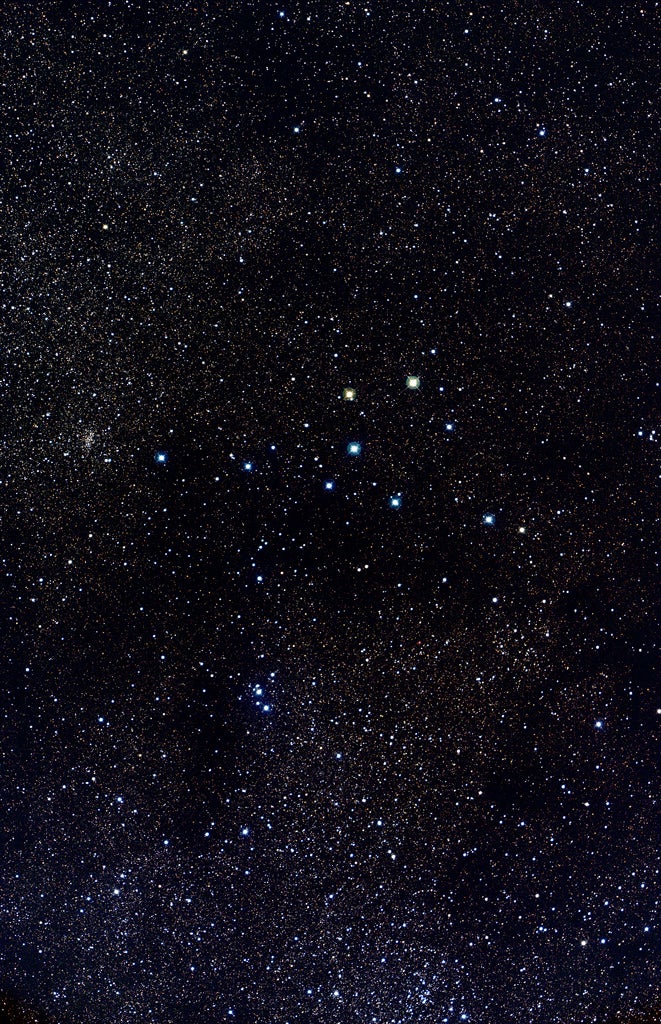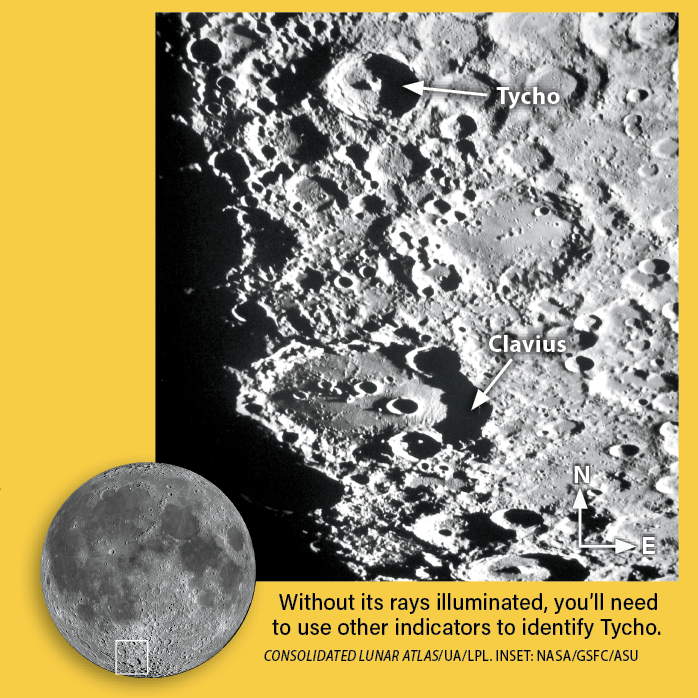
Friday, August 18
Comet C/2023 E1 (ATLAS) is making its closest approach to Earth today, now just 3 light-minutes away. That translates to a distance of about 33.5 million miles (54 million kilometers), rendering the comet a relatively bright 10th magnitude, a ready target for telescopes.
You’ll find ATLAS in eastern Cygnus, right near the Swan’s border with the constellation Pegasus. It’s now about 16.5° southeast of bright Deneb and 13.5° southeast of the famous North America Nebula (NGC 7000). The comet also lies just under 1.5° southeast of the deep red, 6th-magnitude carbon star V460 Cygni, offering a great composition for astrophotos.
ATLAS is visible throughout the evening hours, rising higher through about 1 A.M. local daylight time and setting after the Sun tomorrow morning. If you haven’t managed to set your sights on this icy visitor from the outer solar system, now is the time. ATLAS is now past perihelion (its closest point to the Sun) and is headed back out past Earth into the distant solar system, so it will continue to fade as the weeks go by. It won’t return for some 85 years.
Other events that occur today include the delicate crescent Moon passing 1.1° north of asteroid 2 Pallas as well as 7° north of Mercury at 7 A.M. EDT. The Moon will also pass 2° north of Mars at 7 P.M. EDT — you can catch a glimpse of the pair setting in the west shortly after sunset, before the sky is dark enough to begin hunting down ATLAS.
Sunrise: 6:14 A.M.
Sunset: 7:53 P.M.
Moonrise: 8:13 A.M.
Moonset: 9:12 P.M.
Moon Phase: Waxing crescent (5%)
*Times for sunrise, sunset, moonrise, and moonset are given in local time from 40° N 90° W. The Moon’s illumination is given at 12 P.M. local time from the same location.
Saturday, August 19
Jupiter floats near the 5th-magnitude star Sigma (σ) Arietis for the rest of the month. This morning, you can catch the star masquerading as a Galilean moon!
Jupiter rises shortly before local midnight, so the best time to catch it is in the few hours ahead of sunrise, when it’s higher in the sky. But today, you’ll want to start observing as early as possible, as several events occur between midnight and dawn. Let’s start around 1 A.M. EDT, when Jupiter is flanked by two moons on each side. To the west lie Europa (closest) and Ganymede, while to the east are Io (closest) and Callisto.
In fact, Callisto sits some 10′ east of Jupiter… but there are two bright points of light in that region. Which is the moon? It is the fainter point just farther out; about 2′ closer to the planet is Sigma Ari. The star is actually more in line with the other three moons than Callisto, which lies slightly north of that plane.
Keep watching and you’ll see Io closing in on the gas giant’s eastern limb. Minutes after 1 A.M. EDT, Io’s shadow appears on the cloud tops; the moon follows in a transit that begins more than an hour later, just after 4:20 A.M. EDT. The shadow is more than halfway across by then, leaving the disk around 5:10 A.M. EDT (as twilight is just beginning on the East Coast). Io continues its journey, finally ending its transit around 5:30 A.M. CDT, after sunrise in the Eastern time zone.
Sunrise: 6:15 A.M.
Sunset: 7:51 P.M.
Moonrise: 9:13 A.M.
Moonset: 9:32 P.M.
Moon Phase: Waxing crescent (10%)
Sunday, August 20
The globular cluster M15 lies in far western Pegasus, about 4° northwest of 2nd-magnitude Enif (Epsilon [ε] Pegasi), which marks the Winged Horse’s nose. At magnitude 6.3, the cluster can just be spotted with the naked eye under dark conditions, and it’s already 45° above the eastern horizon some two hours after sunset tonight.
Even a relatively small scope (4 inches) can begin to resolve some of the stars around this ancient cluster’s bright, compact core. Observers often note apparent chains of brighter, easy-to-pick-out stars that spiral out from the center, giving the cluster a slightly oblong appearance. And, if you’re an avid astrophotographer or have a large (12 to 15 inches or more) scope, there’s something particularly special about M15 that you can view: the planetary nebula Pease 1. This bubble of gas, blown off by its aging parent star, is just offset from the cluster’s center. You’ll need magnification of 300x or more, and an OIII filter will further help bring out the gas’ dim glow. Although it’s tough to spot, Pease 1 was the first planetary nebula discovered in a globular cluster — and researchers do believe it is associated with the cluster, rather than a chance superposition.
Even if this challenge is too great, M15 is still a stunning target worth enjoying. Plus, there are other similar sights in the sky — in another few months, we’ll try for the planetary nebula NGC 2438, which sits in front of an open cluster (M46) in the wintertime sky.
Sunrise: 6:16 A.M.
Sunset: 7:50 P.M.
Moonrise: 10:12 A.M.
Moonset: 9:52 P.M.
Moon Phase: Waxing crescent (16%)
Monday, August 21
After passing through inferior conjunction just over a week ago, Venus is back! The bright planet now appears in the morning sky before sunrise, so it’s great for early risers.
At magnitude –4.1, the world is easy to spot, provided you have a clear eastern horizon. It’s nearly 4° high in Cancer the Crab about half an hour before sunrise and climbing. Because it’s so bright, the planet should remain visible even in the growing twilight. If you do opt to view it with binoculars or a telescope, make sure to put them away at least several minutes before sunrise from your location (which may differ slightly from the time given below).
Through those optics, Venus stretches an impressive 56″ across. It currently just 0.3 astronomical unit away, or less than 28 million miles (45 million km). (1 astronomical unit, or AU, is the average Earth-Sun distance.) Its phase is a mere 3 percent, offering only a sliver of sunlit clouds on view. During the rest of August, Venus will rise earlier and its phase will wax, reaching 11 percent lit by the end of the month. At the same time, its size will slightly diminish, shrinking 6″ by the 31st.
Sunrise: 6:17 A.M.
Sunset: 7:49 P.M.
Moonrise: 11:14 A.M.
Moonset: 10:14 P.M.
Moon Phase: Waxing crescent (24%)

Tuesday, August 22
The constellation Vulpecula the Fox lies just south of Cygnus and Lyra in the northern sky. It’s a region rife with deep-sky targets, including the one we’re exploring tonight: Collinder 399, also known as the Coathanger.
This is an easy binocular or small scope object, so it’s great for beginning observers. You’ll find this asterism, or unofficial pattern of stars, within the Summer Triangle bounded by the bright stars Deneb, Vega, and Altair. The last of these three, located in Aquila the Eagle, is our jumping-off point: Look about 13°, or two binocular fields, northeast of this star to find the Coathanger’s distinct shape.
Also called Brocchi’s Cluster, the Coathanger shines collectively at magnitude 3.6, with 10 of its stars brighter than magnitude 7. The entire group spans about 1°, or two Full Moons, so it’s rather large. Its bar is made of six stars in a relatively straight line, while the hook sprouts southward from the middle as a curve of four more stars.
Sunrise: 6:18 A.M.
Sunset: 7:47 P.M.
Moonrise: 12:18 P.M.
Moonset: 10:39 P.M.
Moon Phase: Waxing crescent (33%)
Wednesday, August 23
Mercury has been making its way rapidly east through southern Leo in the evening sky. Today, though, the solar system’s smallest planet stands stationary at 1 A.M. EDT. It will now begin moving westward, or retrograde, against the background stars, heading back toward magnitude 1.4 Regulus, also called Cor Leonis or the Lion’s Heart.
Mercury is getting hard to spot, now magnitude 1 and just 1.5° above the horizon a mere 20 minutes after sunset. You may still be able to sight it through a telescope or even binoculars, but it will be a challenge against the still-bright sky. If you’re able to catch its 10″-wide disk, you should notice that it exhibits a crescent phase some 23 percent lit.
Easier to observe will be Mars, some 7.5° to Mercury’s east (upper left) — the Red Planet is fainter at magnitude 1.8 but will remain in the sky longer as darkness falls, giving its light time to appear before it sinks too low. Mars is located in Virgo, sitting about ¼° due east of 4th-magnitude Beta (β) Virginis. Far to the pair’s east is the Maiden’s slightly brighter 3rd-magnitude gamma star, the beautiful binary system Porrima — certainly worth observing this evening as well!
Sunrise: 6:19 A.M.
Sunset: 7:46 P.M.
Moonrise: 1:26 P.M.
Moonset: 11:10 P.M.
Moon Phase: Waxing crescent (43%)

Thursday, August 24
First Quarter Moon occurs at 5:57 A.M. EDT, bringing half of Luna’s face into sunlight as our satellite rises in the daytime sky. An hour after sunset, as the stars are beginning to appear, the Moon hangs in the south amid the stars of Scorpius, within 1° northwest of the arachnid’s bright red heart.
For most of the world, the Moon will pass 1.1° due north of Antares at 10 P.M. EDT. But many observers in the U.S. and Canada will instead see the Moon completely blot out the star as it passes in front of it from our point of view in an occultation this evening. You can check whether the event is visible from your location on the International Occultation Timing Association’s page for the event, which lists the times of Antares’ disappearance and reappearance from most major cities in the path.
While you’re waiting for the event to begin, you can use a telescope to study the rugged lunar surface, particularly along the terminator dividing night and day. This is where the contrast is greatest and features in the landscape stand out in the greatest detail. But under this Sun angle, some familiar features might also look alien — like the crater Tycho, usually known for its long, light-colored rays that sweep upward from the south. Tonight, Tycho will be much harder to find, those rays all but invisible. Instead, look for nearby Clavius, well known for the small arc of craterlets within its walls. Once you find Clavius, it’s a short jaunt north to Tycho — check out our map above and see if you can find it!
Sunrise: 6:20 A.M.
Sunset: 7:44 P.M.
Moonrise: 2:35 P.M.
Moonset: 11:48 P.M.
Moon Phase: Waxing gibbous (53%)
Friday, August 25
Saturn is now two days from opposition, offering its best views for the year. The ringed planet lies in Aquarius, shining at magnitude 0.4 and creating a bright point of light in the otherwise sparse central regions of the constellation. Two hours after sunset, Saturn is already 20° high in the southeast and continuing to climb. Your best views will come late in the evening and early into tomorrow morning, as it rises far above the turbulent air near the horizon (and any light pollution you might have there as well).
Through a telescope, Saturn is surrounded by its broad ring system. That’s where we’re concentrating our effort tonight and over the next few days, as the rings undergo a phenomenon called the Seeliger effect. This causes the rings to apparently brighten in the few days around opposition, as the Sun moves directly behind Earth as we view Saturn and any shadows cast by ice particles on the rings disappear. To observe the effect, you’ll want to take a peek at Saturn every day for the next week or so — the effect is greatest at opposition, so it should be ramping up now; then, the rings will begin to darken slightly in the days following the 27th. Making a sketch or taking an image each night can help you chart the effect.
You may also be able to easily spot Saturn’s largest moon, Titan, now standing 2.5′ due east of the planet. It will remain east of Saturn through opposition, even as the planet’s fainter, closer-in moons orbit much more quickly, undergoing transits and occultations. Tethys will transit Saturn’s southern polar region starting around 1:45 A.M. EDT tomorrow morning (the 26th for observers in the Eastern and Central time zones, but still Friday night for those in the western half of the U.S.). Because the planet is so close to opposition, the moon and its shadow appear to cross at nearly the same time — Tethys’ shadow just barely leads and may be indistinguishable from the moon itself in many scopes.
Sunrise: 6:21 A.M.
Sunset: 7:43 P.M.
Moonrise: 3:45 P.M.
Moonset: —
Moon Phase: Waxing gibbous (64%)

Sky This Week is brought to you in part by Celestron.









